NISSAN PRIMERA 1999 Electronic Repair Manual
Manufacturer: NISSAN, Model Year: 1999, Model line: PRIMERA, Model: NISSAN PRIMERA 1999Pages: 2267, PDF Size: 35.74 MB
Page 171 of 2267
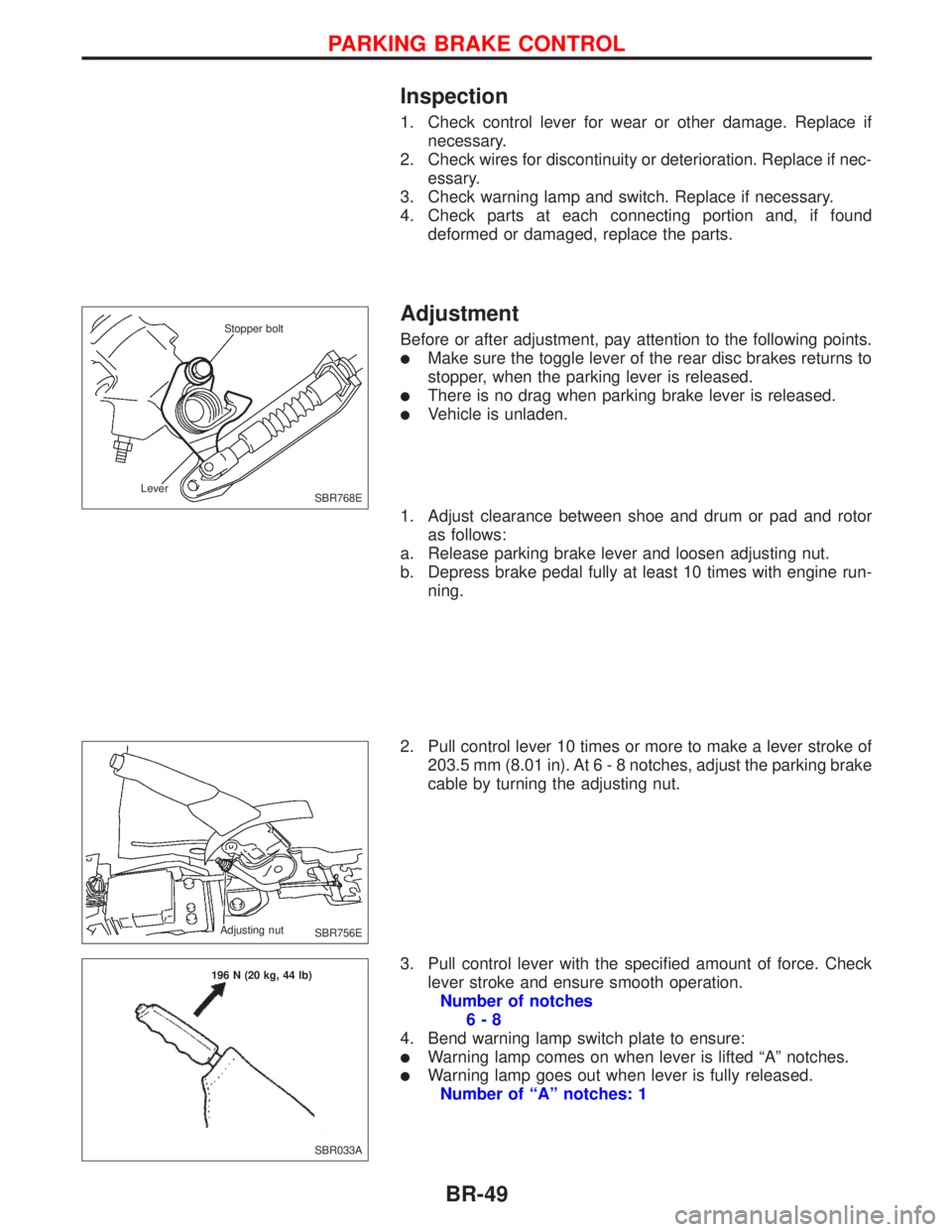
Inspection
1. Check control lever for wear or other damage. Replace if
necessary.
2. Check wires for discontinuity or deterioration. Replace if nec-
essary.
3. Check warning lamp and switch. Replace if necessary.
4. Check parts at each connecting portion and, if found
deformed or damaged, replace the parts.
Adjustment
Before or after adjustment, pay attention to the following points.
lMake sure the toggle lever of the rear disc brakes returns to
stopper, when the parking lever is released.
lThere is no drag when parking brake lever is released.
lVehicle is unladen.
1. Adjust clearance between shoe and drum or pad and rotor
as follows:
a. Release parking brake lever and loosen adjusting nut.
b. Depress brake pedal fully at least 10 times with engine run-
ning.
2. Pull control lever 10 times or more to make a lever stroke of
203.5 mm (8.01 in). At6-8notches, adjust the parking brake
cable by turning the adjusting nut.
3. Pull control lever with the specified amount of force. Check
lever stroke and ensure smooth operation.
Number of notches
6-8
4. Bend warning lamp switch plate to ensure:
lWarning lamp comes on when lever is lifted ªAº notches.
lWarning lamp goes out when lever is fully released.
Number of ªAº notches: 1
SBR768E Stopper bolt
Lever
SBR756E Adjusting nut
SBR033A 196 N (20 kg, 44 lb)
PARKING BRAKE CONTROL
BR-49
Page 172 of 2267
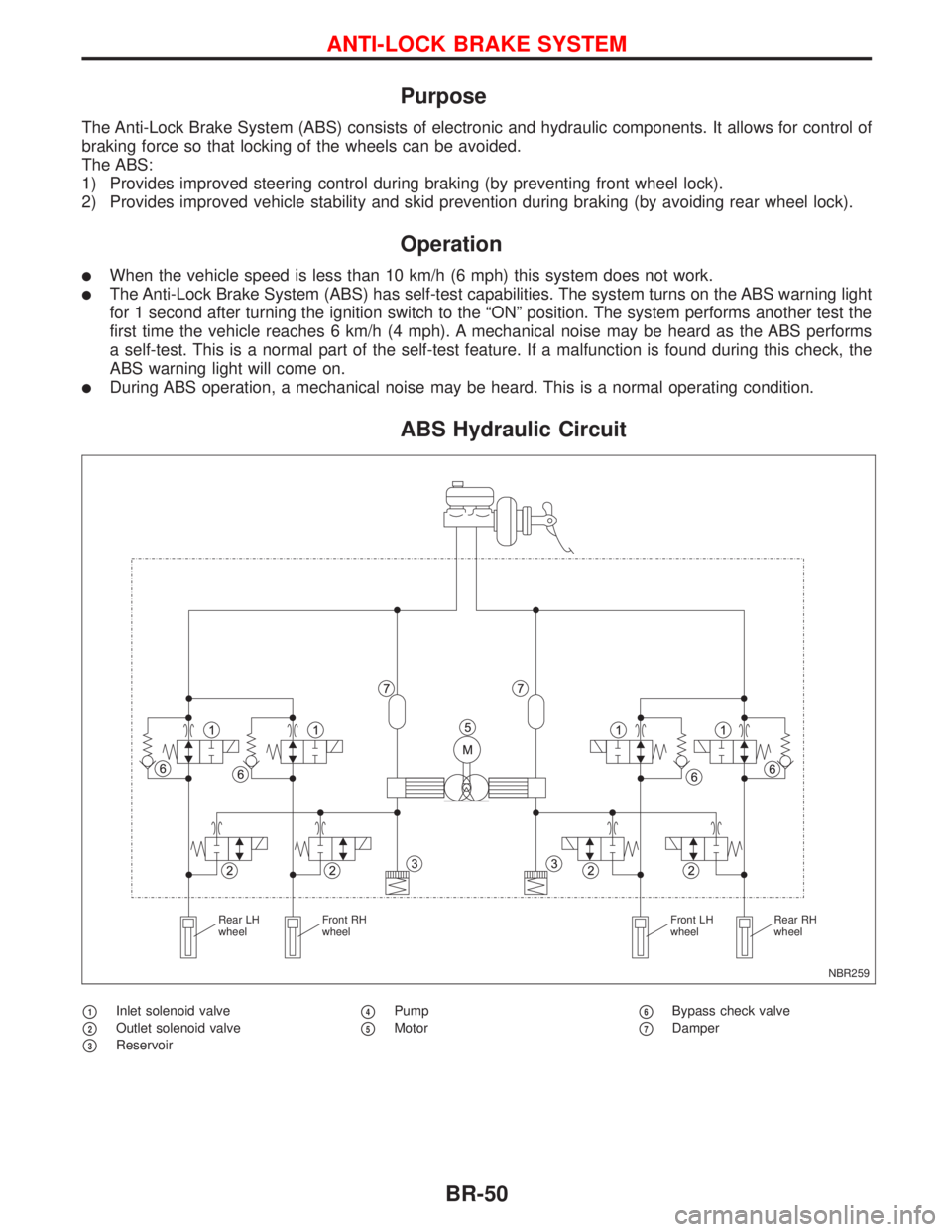
Purpose
The Anti-Lock Brake System (ABS) consists of electronic and hydraulic components. It allows for control of
braking force so that locking of the wheels can be avoided.
The ABS:
1) Provides improved steering control during braking (by preventing front wheel lock).
2) Provides improved vehicle stability and skid prevention during braking (by avoiding rear wheel lock).
Operation
lWhen the vehicle speed is less than 10 km/h (6 mph) this system does not work.
lThe Anti-Lock Brake System (ABS) has self-test capabilities. The system turns on the ABS warning light
for 1 second after turning the ignition switch to the ªONº position. The system performs another test the
first time the vehicle reaches 6 km/h (4 mph). A mechanical noise may be heard as the ABS performs
a self-test. This is a normal part of the self-test feature. If a malfunction is found during this check, the
ABS warning light will come on.
lDuring ABS operation, a mechanical noise may be heard. This is a normal operating condition.
ABS Hydraulic Circuit
p1Inlet solenoid valve
p2Outlet solenoid valve
p3Reservoir
p4Pump
p5Motorp6Bypass check valve
p7Damper
NBR259 Rear LH
wheelFront RH
wheelFront LH
wheelRear RH
wheel
ANTI-LOCK BRAKE SYSTEM
BR-50
Page 173 of 2267
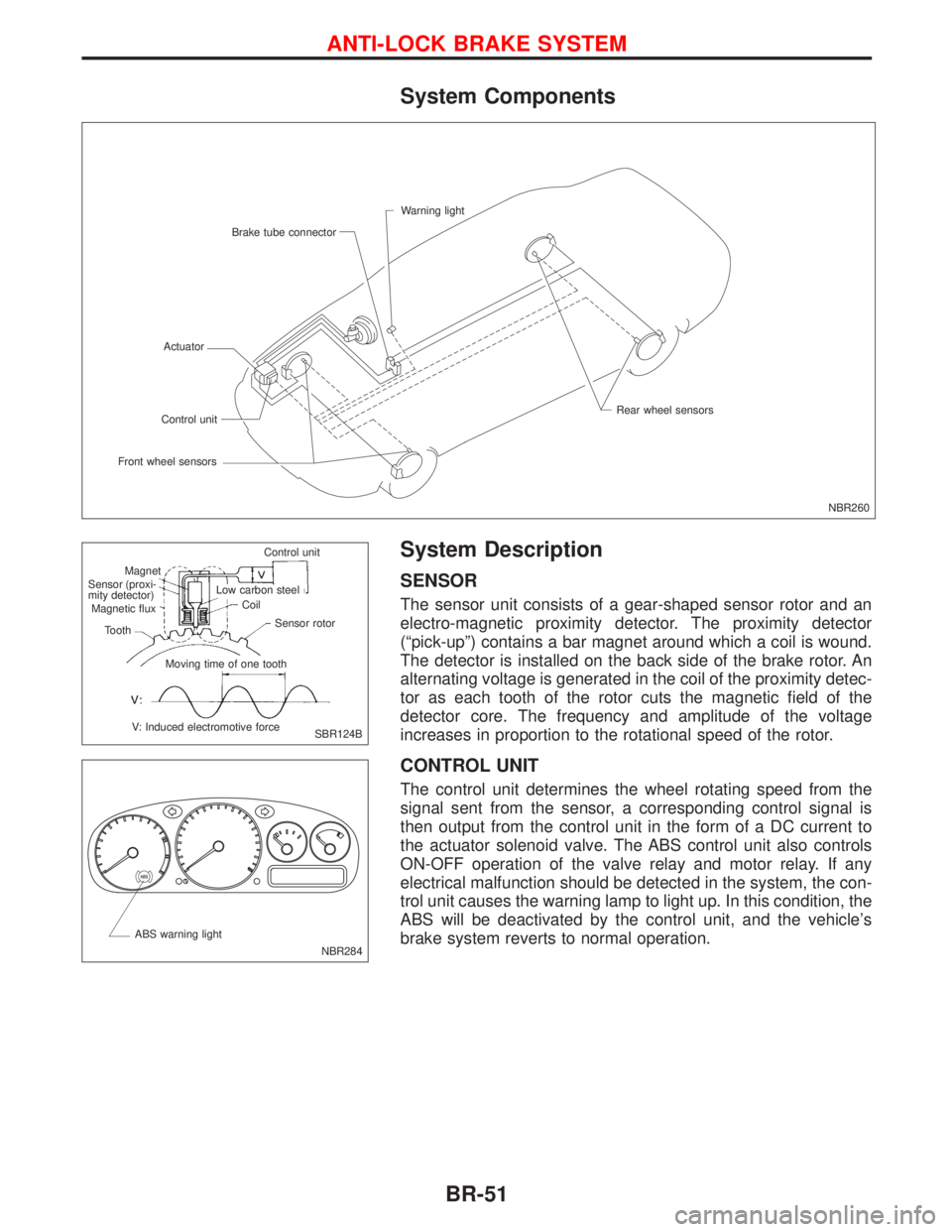
System Components
System Description
SENSOR
The sensor unit consists of a gear-shaped sensor rotor and an
electro-magnetic proximity detector. The proximity detector
(ªpick-upº) contains a bar magnet around which a coil is wound.
The detector is installed on the back side of the brake rotor. An
alternating voltage is generated in the coil of the proximity detec-
tor as each tooth of the rotor cuts the magnetic field of the
detector core. The frequency and amplitude of the voltage
increases in proportion to the rotational speed of the rotor.
CONTROL UNIT
The control unit determines the wheel rotating speed from the
signal sent from the sensor, a corresponding control signal is
then output from the control unit in the form of a DC current to
the actuator solenoid valve. The ABS control unit also controls
ON-OFF operation of the valve relay and motor relay. If any
electrical malfunction should be detected in the system, the con-
trol unit causes the warning lamp to light up. In this condition, the
ABS will be deactivated by the control unit, and the vehicle's
brake system reverts to normal operation.
NBR260 Warning light
Brake tube connector
Actuator
Front wheel sensorsControl unitRear wheel sensors
SBR124B Control unit
Magnet
.Sensor (proxi-
mity detector)
Magnetic flux
Tooth
V: Induced electromotive forceMoving time of one toothSensor rotor Coil Low carbon steel
NBR284 ABS warning light
ANTI-LOCK BRAKE SYSTEM
BR-51
Page 174 of 2267
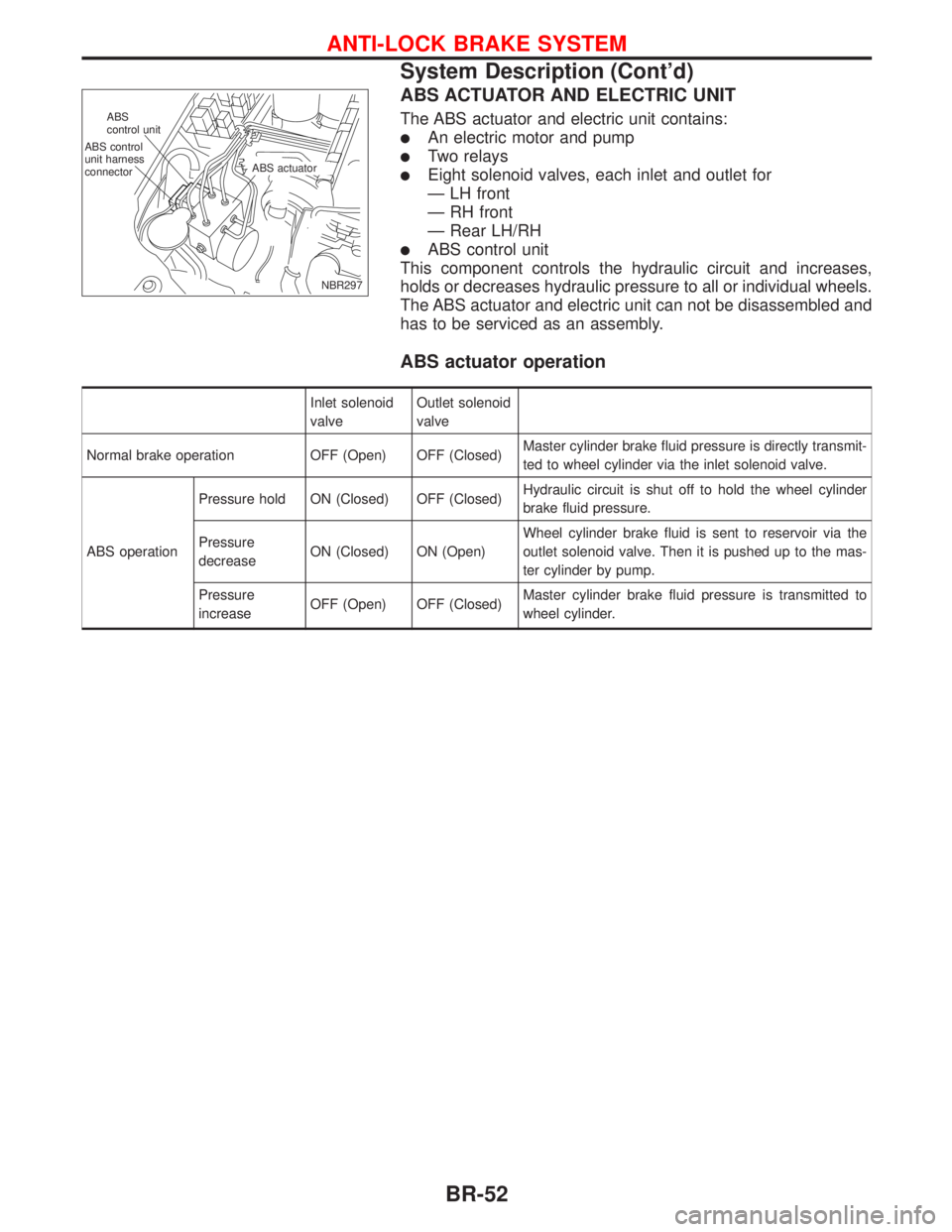
ABS ACTUATOR AND ELECTRIC UNIT
The ABS actuator and electric unit contains:
lAn electric motor and pump
lTwo relays
lEight solenoid valves, each inlet and outlet for
Ð LH front
Ð RH front
Ð Rear LH/RH
lABS control unit
This component controls the hydraulic circuit and increases,
holds or decreases hydraulic pressure to all or individual wheels.
The ABS actuator and electric unit can not be disassembled and
has to be serviced as an assembly.
ABS actuator operation
Inlet solenoid
valveOutlet solenoid
valve
Normal brake operation OFF (Open) OFF (Closed)Master cylinder brake fluid pressure is directly transmit-
ted to wheel cylinder via the inlet solenoid valve.
ABS operationPressure hold ON (Closed) OFF (Closed)Hydraulic circuit is shut off to hold the wheel cylinder
brake fluid pressure.
Pressure
decreaseON (Closed) ON (Open)Wheel cylinder brake fluid is sent to reservoir via the
outlet solenoid valve. Then it is pushed up to the mas-
ter cylinder by pump.
Pressure
increaseOFF (Open) OFF (Closed)Master cylinder brake fluid pressure is transmitted to
wheel cylinder.
NBR297 ABS control
unit harness
connectorABS
control unit
.ABS actuator
ANTI-LOCK BRAKE SYSTEM
System Description (Cont'd)
BR-52
Page 175 of 2267
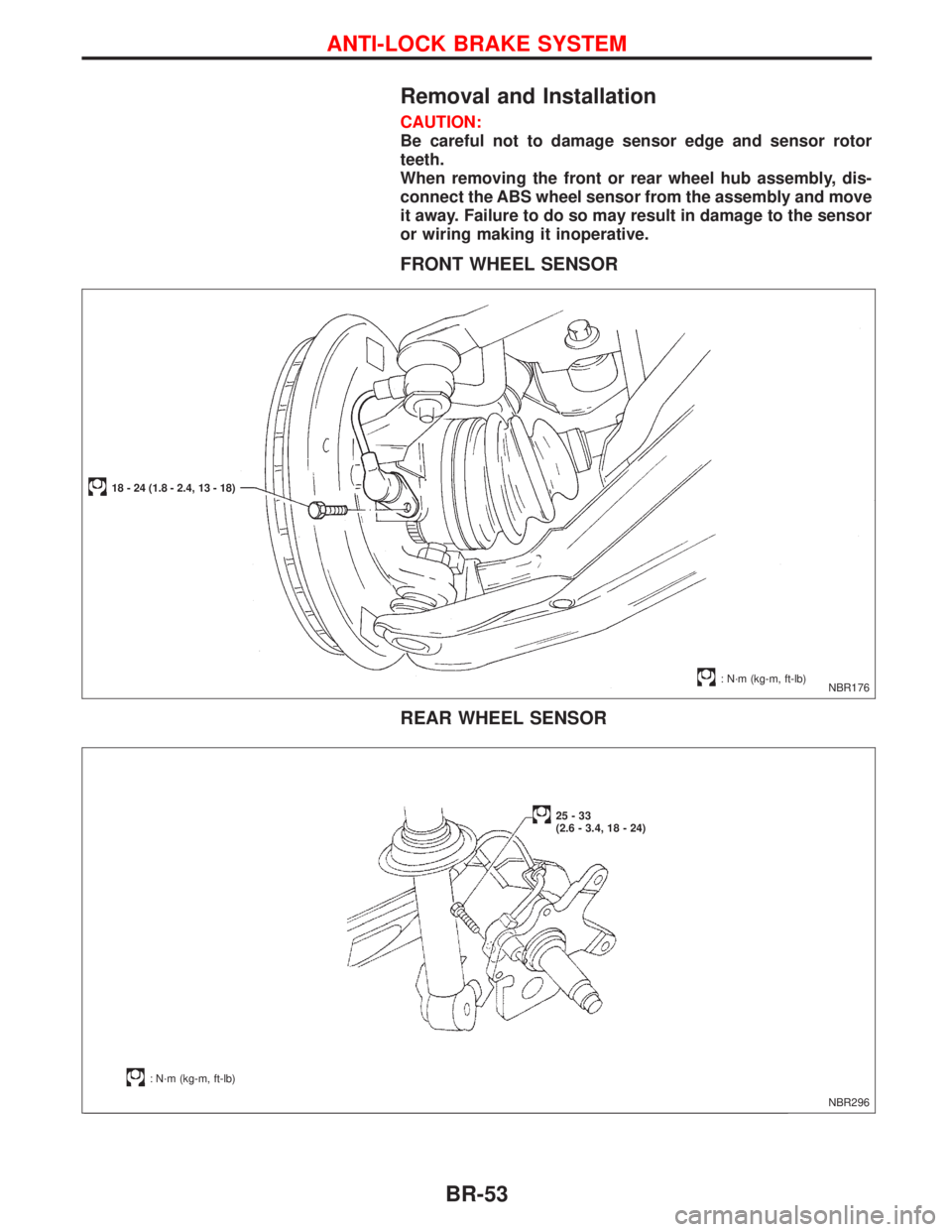
Removal and Installation
CAUTION:
Be careful not to damage sensor edge and sensor rotor
teeth.
When removing the front or rear wheel hub assembly, dis-
connect the ABS wheel sensor from the assembly and move
it away. Failure to do so may result in damage to the sensor
or wiring making it inoperative.
FRONT WHEEL SENSOR
REAR WHEEL SENSOR
NBR176
18 - 24 (1.8 - 2.4, 13 - 18)
: N´m (kg-m, ft-lb)
NBR296
: N´m (kg-m, ft-lb)
25-33
(2.6 - 3.4, 18 - 24)
ANTI-LOCK BRAKE SYSTEM
BR-53
Page 176 of 2267
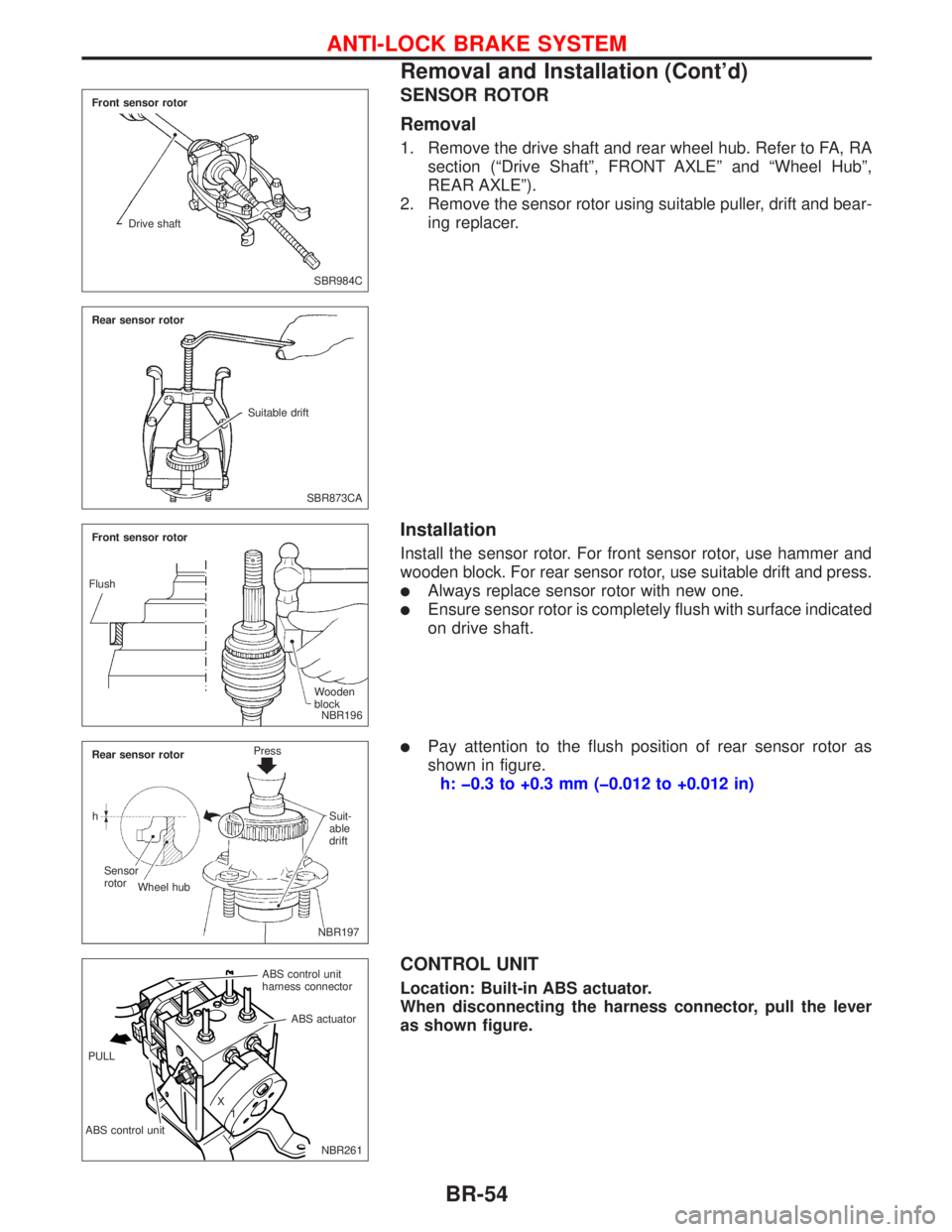
SENSOR ROTOR
Removal
1. Remove the drive shaft and rear wheel hub. Refer to FA, RA
section (ªDrive Shaftº, FRONT AXLEº and ªWheel Hubº,
REAR AXLEº).
2. Remove the sensor rotor using suitable puller, drift and bear-
ing replacer.
Installation
Install the sensor rotor. For front sensor rotor, use hammer and
wooden block. For rear sensor rotor, use suitable drift and press.
lAlways replace sensor rotor with new one.
lEnsure sensor rotor is completely flush with surface indicated
on drive shaft.
lPay attention to the flush position of rear sensor rotor as
shown in figure.
h: þ0.3 to +0.3 mm (þ0.012 to +0.012 in)
CONTROL UNIT
Location: Built-in ABS actuator.
When disconnecting the harness connector, pull the lever
as shown figure.
SBR984C Front sensor rotor
Drive shaft
SBR873CA Rear sensor rotor
Suitable drift
NBR196 Front sensor rotor
Wooden
block Flush
.NBR197 Rear sensor rotorPress
Suit-
able
drift
Sensor
rotor
Wheel hub h
NBR261 ABS control unit
harness connector
ABS control unitABS actuator
X
1
X PULL
ANTI-LOCK BRAKE SYSTEM
Removal and Installation (Cont'd)
BR-54
Page 177 of 2267
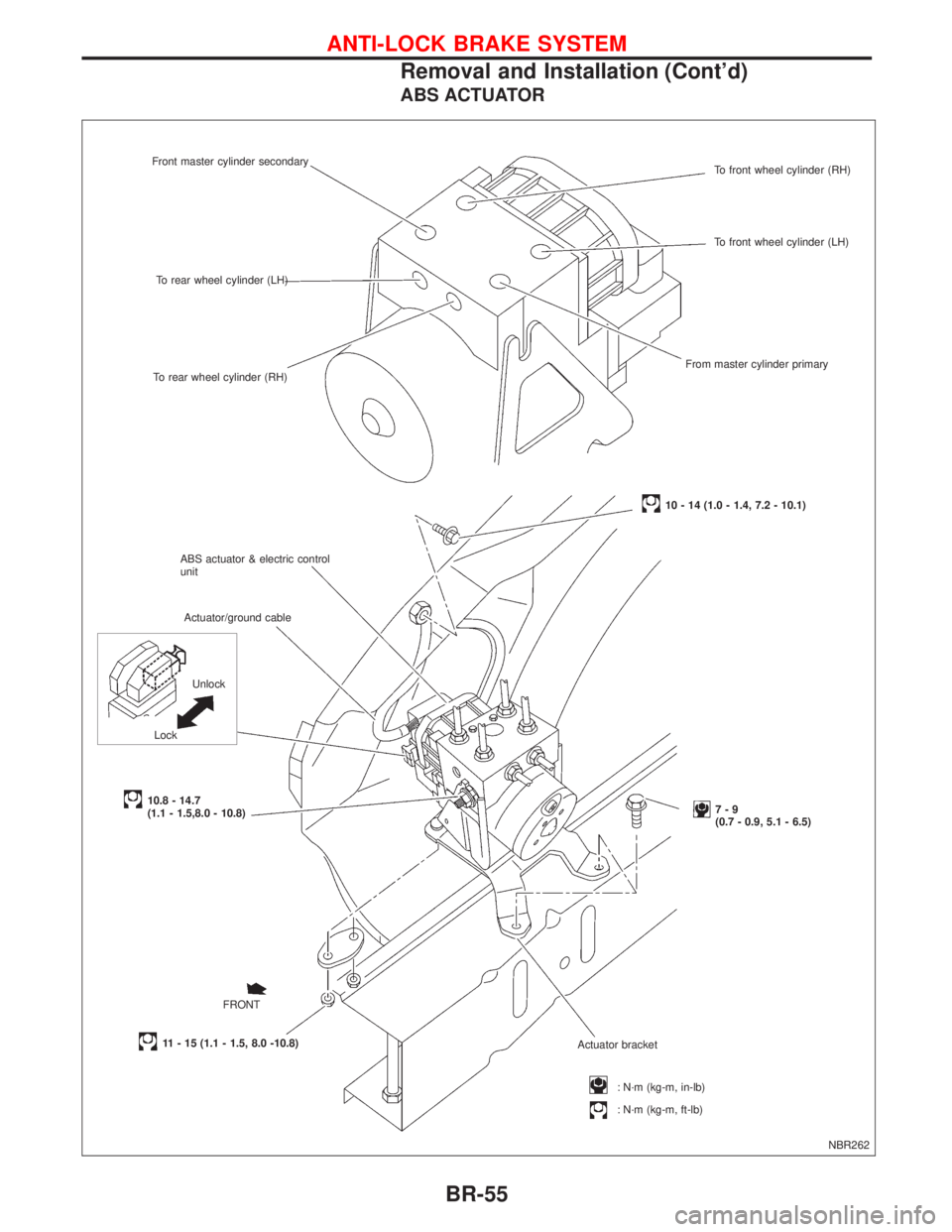
ABS ACTUATOR
NBR262 Front master cylinder secondary
To rear wheel cylinder (LH)
To rear wheel cylinder (RH)
Actuator/ground cable
10.8 - 14.7
(1.1 - 1.5,8.0 - 10.8)
: N´m (kg-m, in-lb)
: N´m (kg-m, ft-lb) Actuator bracket7-9
(0.7 - 0.9, 5.1 - 6.5) ABS actuator & electric control
unit
11 - 15 (1.1 - 1.5, 8.0 -10.8)To front wheel cylinder (RH)
To front wheel cylinder (LH)
From master cylinder primary
10 - 14 (1.0 - 1.4, 7.2 - 10.1)
FRONT LockUnlock
ANTI-LOCK BRAKE SYSTEM
Removal and Installation (Cont'd)
BR-55
Page 178 of 2267
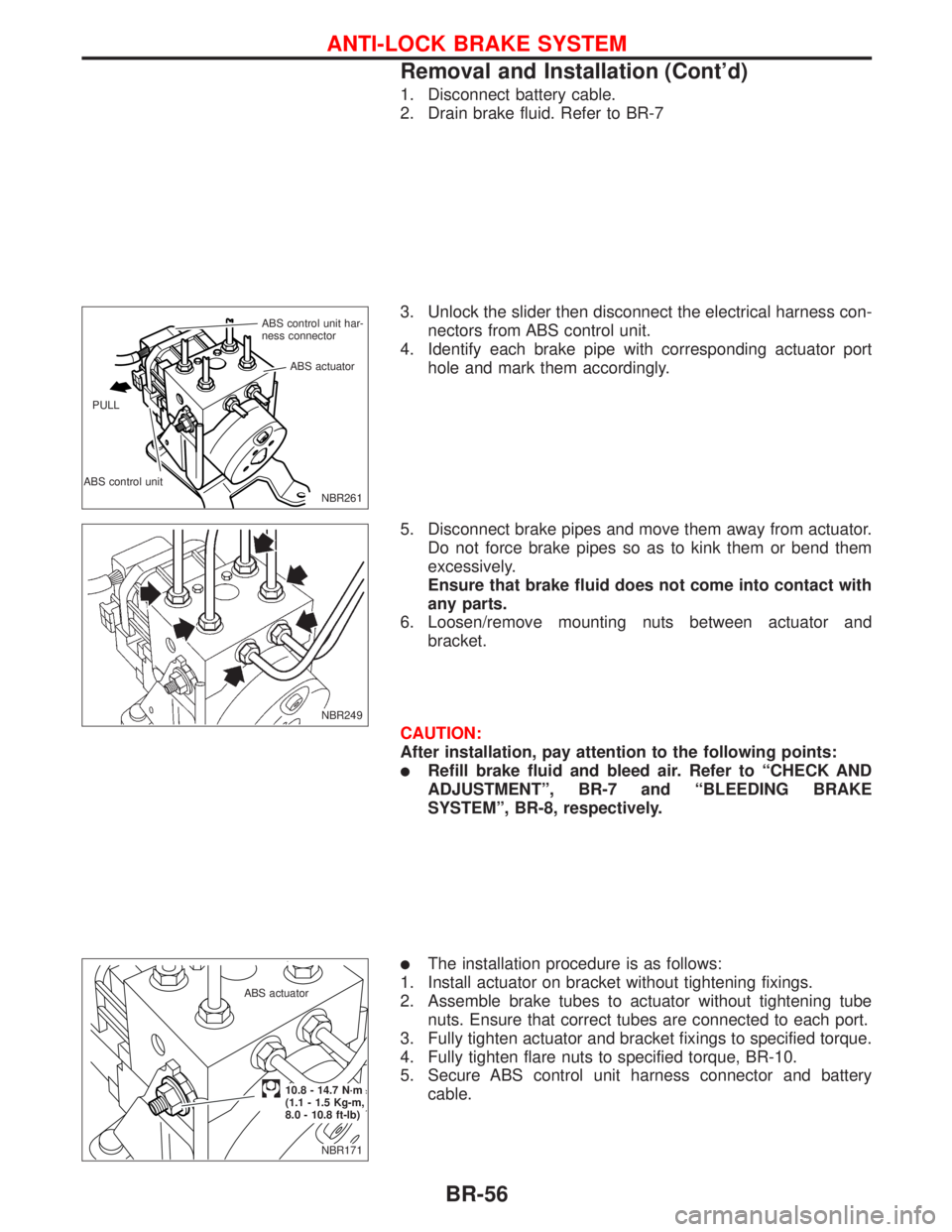
1. Disconnect battery cable.
2. Drain brake fluid. Refer to BR-7
3. Unlock the slider then disconnect the electrical harness con-
nectors from ABS control unit.
4. Identify each brake pipe with corresponding actuator port
hole and mark them accordingly.
5. Disconnect brake pipes and move them away from actuator.
Do not force brake pipes so as to kink them or bend them
excessively.
Ensure that brake fluid does not come into contact with
any parts.
6. Loosen/remove mounting nuts between actuator and
bracket.
CAUTION:
After installation, pay attention to the following points:
lRefill brake fluid and bleed air. Refer to ªCHECK AND
ADJUSTMENTº, BR-7 and ªBLEEDING BRAKE
SYSTEMº, BR-8, respectively.
lThe installation procedure is as follows:
1. Install actuator on bracket without tightening fixings.
2. Assemble brake tubes to actuator without tightening tube
nuts. Ensure that correct tubes are connected to each port.
3. Fully tighten actuator and bracket fixings to specified torque.
4. Fully tighten flare nuts to specified torque, BR-10.
5. Secure ABS control unit harness connector and battery
cable.
NBR261 ABS control unit har-
ness connector
ABS control unitABS actuator
PULL
NBR249
NBR171 ABS actuator
.10.8 - 14.7 N´m
(1.1 - 1.5 Kg-m,
8.0 - 10.8 ft-lb)
ANTI-LOCK BRAKE SYSTEM
Removal and Installation (Cont'd)
BR-56
Page 179 of 2267
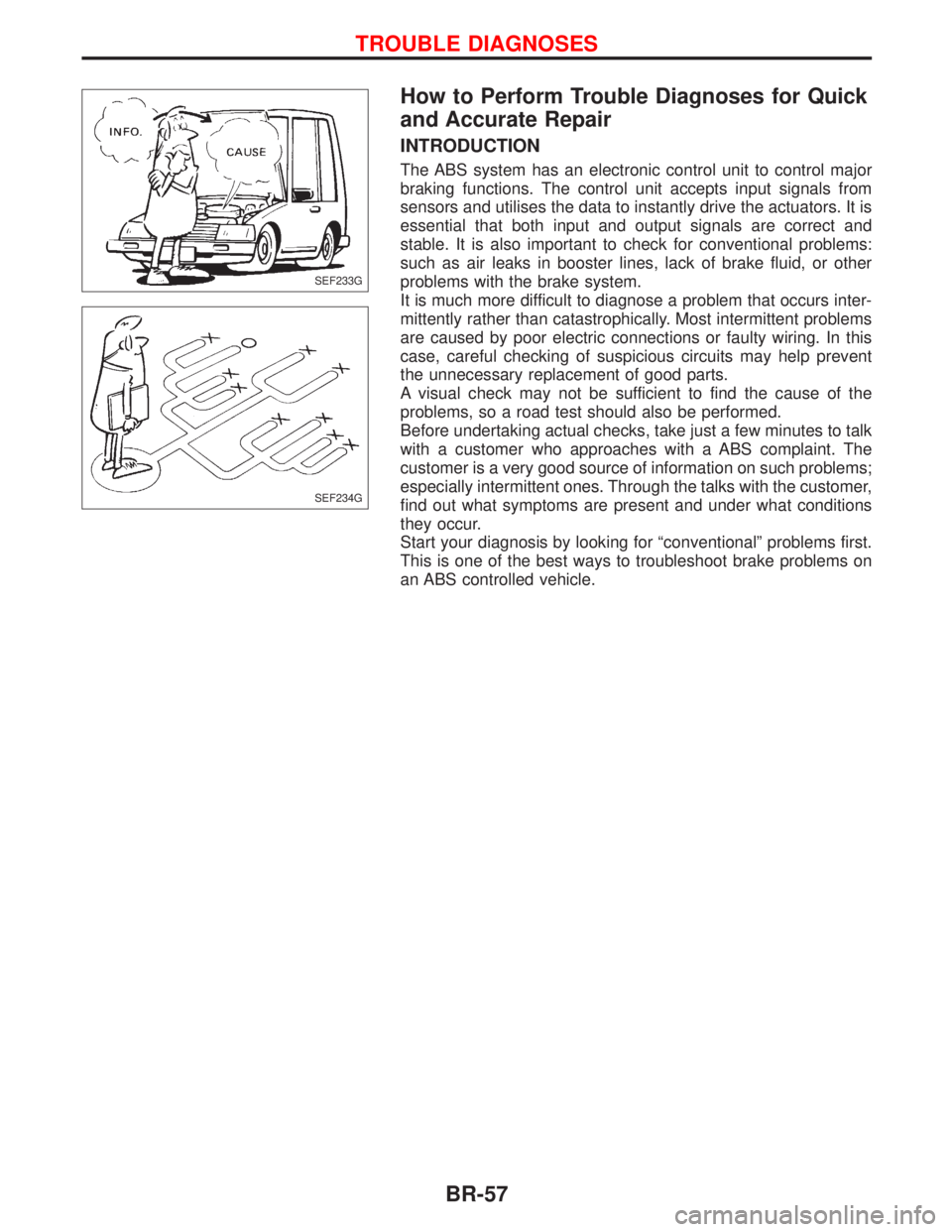
How to Perform Trouble Diagnoses for Quick
and Accurate Repair
INTRODUCTION
The ABS system has an electronic control unit to control major
braking functions. The control unit accepts input signals from
sensors and utilises the data to instantly drive the actuators. It is
essential that both input and output signals are correct and
stable. It is also important to check for conventional problems:
such as air leaks in booster lines, lack of brake fluid, or other
problems with the brake system.
It is much more difficult to diagnose a problem that occurs inter-
mittently rather than catastrophically. Most intermittent problems
are caused by poor electric connections or faulty wiring. In this
case, careful checking of suspicious circuits may help prevent
the unnecessary replacement of good parts.
A visual check may not be sufficient to find the cause of the
problems, so a road test should also be performed.
Before undertaking actual checks, take just a few minutes to talk
with a customer who approaches with a ABS complaint. The
customer is a very good source of information on such problems;
especially intermittent ones. Through the talks with the customer,
find out what symptoms are present and under what conditions
they occur.
Start your diagnosis by looking for ªconventionalº problems first.
This is one of the best ways to troubleshoot brake problems on
an ABS controlled vehicle.
SEF233G
SEF234G
TROUBLE DIAGNOSES
BR-57
Page 180 of 2267
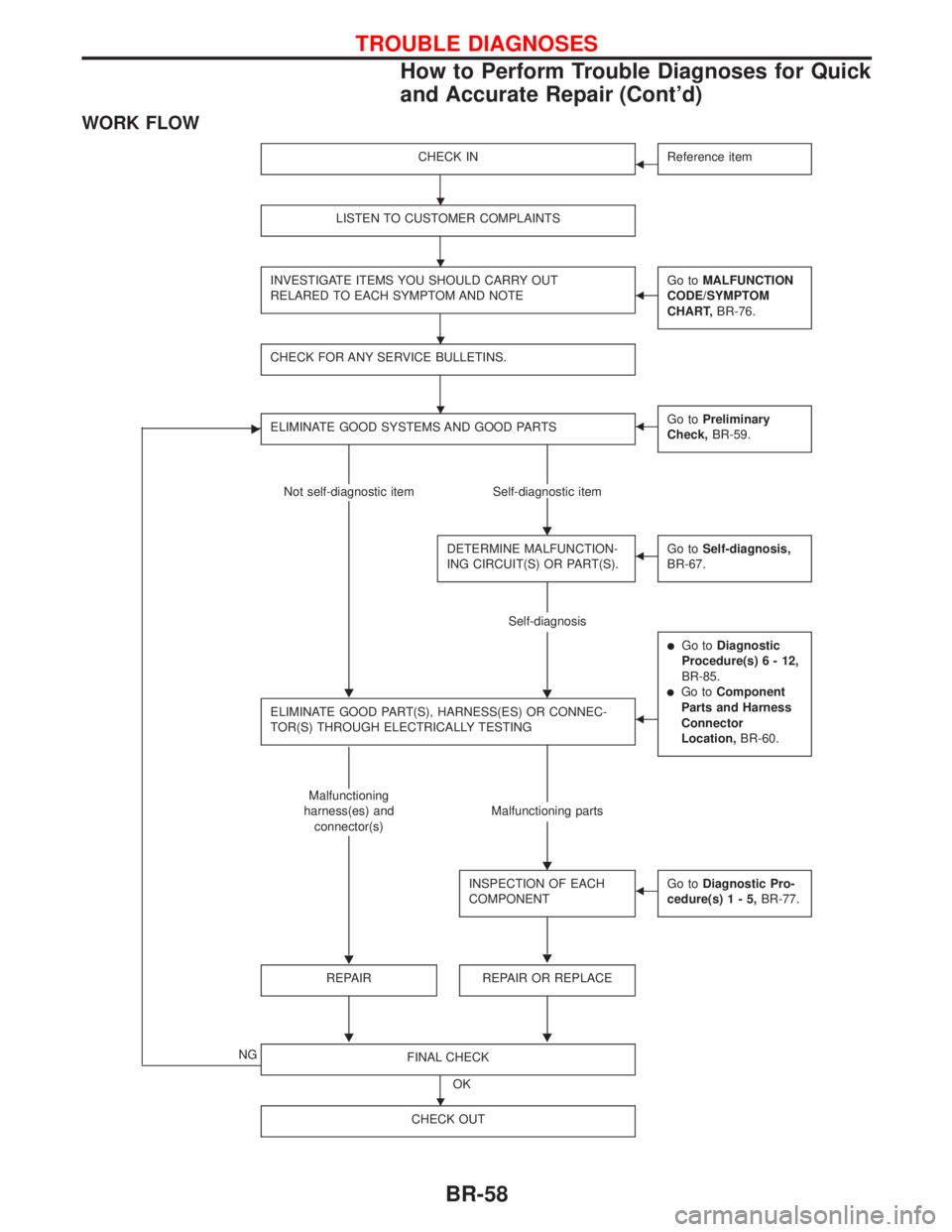
WORK FLOW
CHECK INFReference item
LISTEN TO CUSTOMER COMPLAINTS
INVESTIGATE ITEMS YOU SHOULD CARRY OUT
RELARED TO EACH SYMPTOM AND NOTEFGo toMALFUNCTION
CODE/SYMPTOM
CHART,BR-76.
CHECK FOR ANY SERVICE BULLETINS.
EELIMINATE GOOD SYSTEMS AND GOOD PARTSFGo toPreliminary
Check,BR-59.
Not self-diagnostic item Self-diagnostic item
H
H
DETERMINE MALFUNCTION-
ING CIRCUIT(S) OR PART(S).
FGo toSelf-diagnosis,
BR-67.
Self-diagnosis
H
lGo toDiagnostic
Procedure(s)6-12,
BR-85.
lGo toComponent
Parts and Harness
Connector
Location,BR-60.
ELIMINATE GOOD PART(S), HARNESS(ES) OR CONNEC-
TOR(S) THROUGH ELECTRICALLY TESTINGF
Malfunctioning
harness(es) and
connector(s)Malfunctioning parts
H
H
INSPECTION OF EACH
COMPONENT
FGo toDiagnostic Pro-
cedure(s)1-5,BR-77.
H
REPAIR
REPAIR OR REPLACE
HH
NG
FINAL CHECK
OK
CHECK OUT
H
H
H
H
H
TROUBLE DIAGNOSES
How to Perform Trouble Diagnoses for Quick
and Accurate Repair (Cont'd)
BR-58